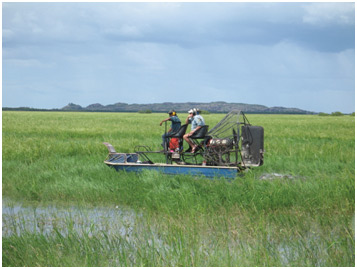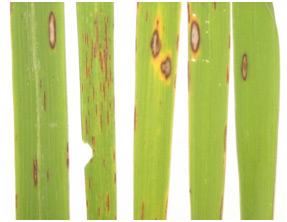Rice blast, caused by Magnaporthe grisea, is generally considered the most important disease of rice worldwide because of its extensive distribution and destructiveness under favourable conditions. South-eastern Australia is the only rice-growing area in the world free of this disease. M. grisea can infect and produce lesions on all parts of the plant and the fungus can infect rice plants at any growth stage.
A rice blast model developed earlier and run for the period 1988-1999 with the meteorological data of four representative locations in the Australian rice growing area highlighted the potential threat of rice blast to the Australian rice industry. Out of a possible 11 years run in the model, the number of years favourable for outbreaks of blast ranged from two at Griffith to nine at Yanco.
Research outcomes
Surveys were conducted in 2006 in the flood plains of the Adelaide and Alligator Rivers at the end of each wet season using airboats to access flooded remote regions. In 2007, similar areas were surveyed together with the Mareeba wetlands in northern Queensland and various Oryza populations in the Kununurra region of Northern Territory. Disease lesions on leaves of wild rice were collected and treated by standard plant pathology methods to isolate causal organisms on agar for later identification. Pathogenicity tests on cultivars of domestic rice (O. sativa) were conducted at Charles Sturt University, Wagga Wagga, New South Wales.
Although many samples displayed leaf lesions very similar to those reported to be caused by the blast fungus Magnaporthe grisea, no conidia resembling this pathogen were observed on field material and the fungus has not been isolated from any lesion type. Three fungal genera, Bipolaris, Curvularia and Nigrospora have been isolated from leaf lesions and identification is in progress together with pathogenicity testing. A previously unreported smut disease of wild Oryza spp. has been identified as a Tilletia species new to science. It appears to have some negative effects on the physiology of domestic rice. Four bacterial pathogens of rice, Pantoea ananatis, Acidovorax avenae, Burkholderia cenocepacia (possibly B. gladioli) and B. cepacia, were found consistently associated with diseased flag, sheath and node lesions.
Research implications
The incidence of blast in northern regions should pose no threat to the domestic rice industry. Further testing of the pathogenicity of the new smut fungus to domestic rice cultivars should be a matter of high priority.
Acknowledgments
Considerable assistance was given to the planning and execution of the project by Dr Penny Wurm, Charles Darwin University, without whom the sampling would have been more difficult and restricted in locality.
Dr Roger Shivas, DPI, Qld, identified and described the new species of smut fungus.
Dr Karen Gibb, CDU, provided laboratory space for isolations in 2006 and Jane Ray, pathologist with AQIS, NT, provided laboratory space and logistics in 2007.
Dr Andrew Mitchell, NAQS, NT, and Drs Carol and Lindsay Campbell University of Sydney, confirmed Oryza identifications.
Tracey Vinnecombe, Agriculture WA, assisted greatly with a survey of the region north of Kununurra in 2007.

Access to the flood plains was achieved by using airboats

Disease symptoms commonly found on Oryza spp in 2006

